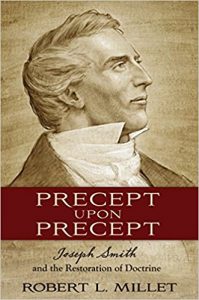Title: Precept Upon Precept: Joseph Smith and the Restoration of Doctrine
Author: Robert L. Millet
Publisher: Deseret Book
Genre: LDS Church History/Historical Theology
Year Published: 2016
Number of Pages: 475
Binding: Hardback
ISBN10: 1629722367
ISBN13: 978-1629722368
Price: $20.99
Reviewed by Carl J. Cranney for the Association for Mormon Letters
A welcome book by former BYU professor of religion Robert L. Millet, Precept Upon Precept takes as its thesis the concept that the Restoration was given, doctrinally, line upon line and precept upon precept. Millet points out in the introduction that “[Joseph’s] divine schooling, like that of all Saints, was incremental” (ix). In short, the Joseph that walked out of the Sacred Grove was not the Joseph prepared to give the King Follett discourse.
While this seems an obvious thesis, Millet is concerned that we sometimes give Joseph more credit than he deserves for his teachings being perfectly identical from beginning to end. Depending on the individual topic, they are not.
The book uses two methods to demonstrate its basic thesis. First, it goes systematically through the doctrines of the Restoration and treats them each individually in the order that they were revealed (though there could be some quibbles about the order and topic choices made by Millet). The first real chapter on a theological topic is “Another Testament” and is primarily about the Book of Mormon and doctrines that are contained therein. The next is “Divine Authority Restored,” and talks about priesthood authority.
The basic format should be obvious—Millet is dealing with individual doctrines in the chronological order they were restored and implemented, in this case the translation of the Book of Mormon and then the restoration of the priesthood. The concept of “precept upon precept” is therefore built into the very structure of the book itself as Millet walks us through various doctrines taught by the prophet Joseph Smith in the order that Joseph did so.
On the issue of God’s corporeality, for example, there are various treatments of the issue (it does not get its own chapter). Millet states early on that, “We are uncertain what the young prophet learned at the time of the First Vision relative to the corporeality or physical body of God the Father. Joseph certainly may have been taught or recognized that God has a physical body, but he did not say so.” (26). Subsequent chapters discuss the understanding of God’s corporeality from the Lectures on Faith and then Joseph’s Nauvoo sermons, demonstrating through the length of the book that Joseph’s view of this issue grew and developed over time.
Other topics are similarly discussed through the duration of the book, though the overall point is clear that Joseph’s understanding changed and increased throughout his life.
The second method the book takes up to demonstrate its basic thesis, and the one that is more effective in my opinion, is the treatment of the individual topics in their own chapters. Some of these topics lend themselves more to this method than others. A good example would be the chapter titled “Those Who Never Heard the Gospel.” Here Millet begins by asserting that, around 1832, Joseph “had not yet grasped the concept of salvation for the dead” (258). Millet then walks us through the 1836 vision of the celestial kingdom (now D&C 137), which surprises Joseph because his unbaptized brother, Alvin, long since passed, was seen in the Celestial Kingdom! Joseph wondered how this could be so, eventually preaching what theologians call “middle knowledge”—that God judges you by what you would have done under more ideal circumstances.
However, Joseph’s phase of preaching “middle knowledge” was eventually supplanted by the final development of the issue—baptisms and temple work for the dead. They represent the culmination of Joseph’s revelations on the subject of salvation for those who never heard the gospel. So Millet takes us from Joseph unaware of salvation for the dead, to an idea of “middle knowledge,” and finally to the doctrine of post-mortem evangelization and temple work for the dead, as clear a progression as could probably be found in the prophet’s theological and revelatory development.
These two methods demonstrate well the overall point that Millet is making—that the restoration did not occur all at once, and that we should take care to keep this in mind when studying the life and teachings of Joseph Smith.
While I found a few historical inadequacies (there was no mention of the seerstone during the chapter on the Book of Mormon translation, for example), the book takes its thesis seriously and demonstrates it handily. Readers familiar with Millet and his style will enjoy the asides and stories he shares as he moves through his discussion. The book has a very familiar feel, as if talking to a friend more than reading an academic treatise.
I suspect this is what Millet was aiming for, and he succeeds. It comes across as more scholarly than a hagiography, but also serves to give readers faith-promoting insight into the life and theological evolution of the LDS founding prophet. The book should feel at home for Latter-day Saints hoping to dip their toes into a slightly more scholarly approach to early church history and the life of Joseph Smith, and as such is a welcome publication by Deseret Book.

